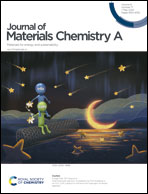A series of highly stable porphyrinic metal–organic frameworks based on iron–oxo chain clusters: design, synthesis and biomimetic catalysis†
Abstract
Iron-based porphyrinic metal–organic frameworks (PMOFs) are desirable for biomimetic applications, due to the low toxicity and high abundance of Fe as well as the rich biomimetic functions of metalloporphyrins. Besides, the uniform dispersion of porphyrin centers in PMOFs can effectively protect them from self-dimerization. Nevertheless, it remains a big challenge to synthesize iron-based PMOFs. In this study, a series of Fe–oxo chain-based PMOFs incorporating different metals in porphyrinic centers (namely M-PMOF-3(Fe), M = Fe, Co, Ni, Cu) are synthesized directly from the reaction of metalloporphyrin and iron salts with an improved modulating strategy using a pair of monocarboxylic acids and water as the three-component modulator. The prepared materials of M-PMOF-3(Fe) possess high stability to resist a broad pH range (0–11) and even 2 M HCl in aqueous solutions for 2 days, and their frameworks can be maintained up to 350 °C. Catalytic tests show that M-PMOF-3(Fe) are effective in the aerobic oxidation of C–H bonds using oxygen from the air as the oxidant.



 Please wait while we load your content...
Please wait while we load your content...